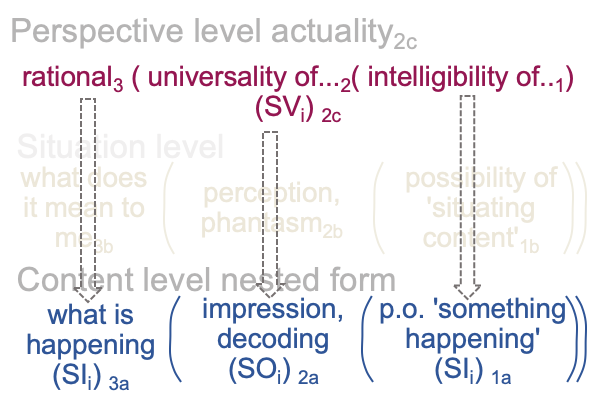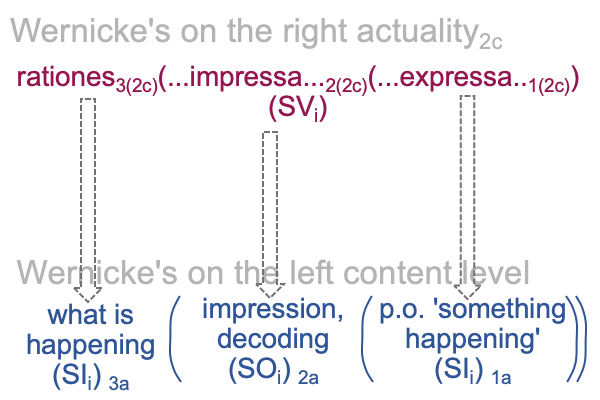0308 How disturbing is that off-hand contention?
Well, it is as disturbing as the realization that the person who applies the Heimlich maneuver harbors a commitment2c, that is, a rationality3(2c) that brings the universality of sensation2(2c) into relation with the potential intelligibility of perception1(2c).
Or should I say…?
A training3(2c) that brings the recognition of the universal signs of choking2(2c) into relation with a potentially intelligible course of action called “the Heimlich maneuver”1(2c).
0309 Is that the same as an auditory hallucination2c?
Yes, it is, to a scientific observer who figuratively stands outside the system. Most sign-vehicles can be observed and measured. The sign-vehicle of the interventional sign-relation (SVi) cannot be observed and measured.
So, is the auditory hallucination a phenomenon? Or is it a model that Jaynes places over the noumenon, the thing itself, in order to integrate the subsequent phenomena, which includes all the statements pertaining to the spouting of the brussels sprout.
0310 Even though the claim that the hero saves the day because of an auditory hallucination sounds disrespectful, at least the claim opens natural inquiry into the element of the interventional sign-relation that cannot be observed and measured, the sign-vehicle (SVi). An auditory hallucination2c (SVi) stands for all the statements about the spouting incident2a (SOi) in regards to a joke-filled dinner happening3a operating on the potential of brussels sprouts as one of the dishes served1a (SOi).
0311 No, the lesson is not, “Do not put an entire brussels sprout in one’s mouth before laughing at a funny story.”
0312 Nor is the lesson that grandfather’s guardian angel shouted into the ear of his son-in-law, who is a fireman fully trained in life-saving techniques.
But, the latter is fairly close to what Jaynes tries to pin down with his technical vocabulary.
0313 If Jaynes’s technical term, “auditory hallucination”, corresponds to the interventional sign-vehicle (SVi), then we may appreciate the term for what it is, a model of a sign-element that cannot be directly observed and measured, but produces phenomena that can be observed and measured, directly, as an interventional sign-object (SOi), and indirectly, as an interventional sign-interpretant (SIi).
0314 In the interventional sign-relation, a perspective-level actuality2c (SVi) stands for a content-level actuality2a (SOi) in regards to a content-level normal context3a operating on its potential1a (SIi).
The following figure reduces the sign-relation to a correspondence, thirdness3(2c) with thirdness3a, secondness2(2c) with secondness2a, and firstness1(2c) with firstness1a.
Say what?
Compare commitment2c (as a category-based nested form unfolded from judgment2c) and the contenta-level of the scholastic interscope for how humans think.

0315 The associations are profound, because they allow the inquirer to appreciate the implicit nature of the interventional sign-relation. If commitment2c is present, as it always is under conditions when hominins communicate through hand-talk, then what is happening3a is implicitly confounded with rationality3(2c) and the potential of ‘something happening’1a should implicitly be entangled with an intelligible perception1(2c). Also, the universality of the sensation2(2c), including… dare I say… synaesthetic cross-modal mentation2(2c)… gets rapidly decoded into a kind of impression, a species impressa2a.
0316 What about the brain?
Julian Jaynes focuses on the Wernicke’s region in the left hemisphere, which encompasses a deep cleft that partially defines the temporal lobe, and a less anatomically well-defined mirror region in the right hemisphere. I call these regions, “Wernicke’s on the left and on the right”.
0317 Wernicke’s region on the left is devoted to rapidly decoding both hand talk and speech talk. The decoded meaning, presence and message provide an impression2a (of what is happening3a given the potential of ‘something happening’1a). The decoded impression2a is integrated with sensory information and feelings that we attribute to sensation2a (that is the dyad, {active body [substantiates] sensate soul}2a).
Content-level elements associate to the sign-object (SOi) and the sign-interpretant (SIi) of the interventional sign-relation.
0318 Julian Jaynes assigns the source of “auditory hallucinations” to the Wernicke’s region on the right. In light of this discussion, that assignment should correspond to the sign-vehicle of the interventional sign-relation (SVi). That SVi is commitment2c as the unfolding of judgment2c.
According to the scholastic ideal, commitment2c is a category-based nested form where the normal context of rationes3(2c) brings the actuality of a species impressa intelligibilis2(2c) into relation with the possibility of a species expressa intelligibilis1(2c).
That is to say, a rational normal context3(2c) brings the actuality of the universality of sensation2(2c) into relation with the possibility of an intelligible perception1(2c).
The SVi (from the Wernicke’s region on the right) is decoded (SIi, by Wernicke’s region on the left) into a SOi.
0319 Here is a picture of the association.

0320 The above figure portrays a phenotype.
The above figure represents an adaptation into the human niche.
According to the masterwork, The Human Niche, by Razie Mah (available at smashwords and other e-book venues), the human niche is the potential of triadic relations.
